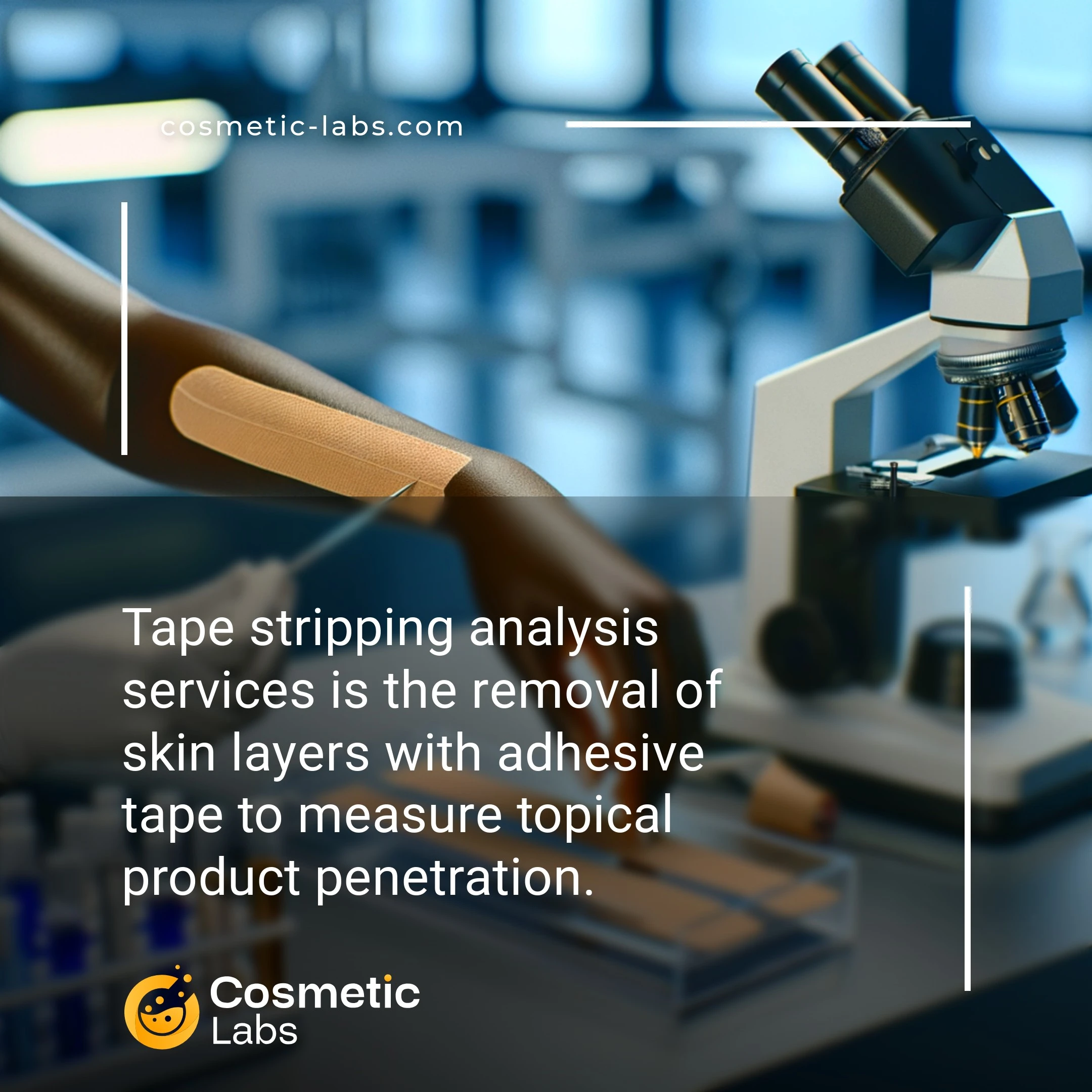Tape Stripping Analysis Services for Cosmetic Product Testing and Development

What is Tape stripping analysis?
Tape stripping analysis is a non-invasive testing method where cosmetic labs apply adhesive strips to skin surfaces to collect and analyze product penetration through the stratum corneum layers. Labs use this technique to measure how deeply your formulation’s active ingredients penetrate—typically examining 10-20 sequential strips to create a concentration gradient profile that shows exactly where ingredients accumulate in skin layers. Unlike traditional biopsy methods, tape stripping provides real-time data about product absorption without damaging skin tissue, making it ideal for comparing formulations or validating penetration enhancer effectiveness.
Why do you need this service?
Cosmetic labs use tape stripping to validate your sunscreen’s SPF claims by measuring UV filter distribution across skin layers after application. This non-invasive technique also tracks how your anti-aging serum’s active ingredients penetrate through the stratum corneum over 2-8 hours, providing real penetration data that proves your product works as intended before costly clinical trials.
Who provides Tape stripping analysis services?
All cosmetic labs providing Tape stripping analysis services
There is no company providing these services at the moment.
Tape Stripping Analysis for Skin Penetration Testing
Tape stripping analysis measures how your cosmetic ingredients penetrate through skin layers. This non-invasive method helps labs determine if your active ingredients reach their target depth and how much product remains on the skin surface versus absorbing into deeper layers.
How Labs Perform Tape Stripping Tests
Testing labs apply your product to skin samples, then use adhesive tape to remove successive layers of the stratum corneum. Each strip captures cells and product residue from different depths.
The process typically involves:
- Application of 2-10 mg/cm² of test product
- Collection of 10-20 tape strips per test site
- Chemical analysis of each strip using HPLC or spectroscopy
- Depth profiling to map ingredient distribution
Labs can test on human volunteers, ex vivo skin samples, or reconstructed skin models depending on your regulatory requirements and budget.
Applications for Product Development
Tape stripping data helps you optimize formulations before expensive clinical trials. Labs use these results to compare different delivery systems and adjust your formula’s penetration enhancers.
Common applications include:
- Validating sunscreen film formation and UV filter distribution
- Testing anti-aging actives like retinoids and peptides
- Measuring skin lightening agent penetration
- Comparing generic versus branded formulations
Results typically show concentration gradients within 48-72 hours, giving you rapid feedback for formula adjustments. Partner labs on our platform offer tape stripping as part of their preclinical penetration studies, often bundled with Franz cell diffusion tests for complete penetration profiles.
Real-World Applications of Tape Stripping Analysis in Cosmetic Development
Tape stripping analysis provides quantifiable data about product absorption and skin barrier function, making it indispensable for validating formulation claims and optimizing delivery systems.
Active Ingredient Penetration Testing
Labs use tape stripping analysis services to measure how deeply actives like retinol, vitamin C, and peptides penetrate the stratum corneum. The technique involves applying adhesive tapes sequentially to remove skin layers, then analyzing each strip for ingredient concentration.
This data helps formulators adjust particle sizes, pH levels, and carrier systems to achieve target penetration depths. For instance, a sunscreen needs to remain in upper layers while anti-aging serums require deeper penetration—tape stripping quantifies these differences precisely.
Bioavailability and Efficacy Validation
Cosmetic labs employ tape stripping to demonstrate product bioavailability across different skin types and conditions. By collecting samples at 30-minute, 2-hour, and 8-hour intervals, technicians create penetration profiles that support marketing claims.
The method also validates delivery technologies like liposomes and microspheres. Labs compare penetration rates between encapsulated and free-form ingredients, providing concrete evidence of enhanced delivery performance that brands need for product differentiation.
| Application Type | Testing Parameters | Typical Timeline | Key Outputs |
|---|---|---|---|
| Moisturizer Studies | Water content, NMF levels | 24-48 hours | Hydration depth profiles |
| Anti-aging Formulas | Peptide/retinoid concentration | 7-14 days | Penetration kinetics data |
| Sunscreen Analysis | UV filter distribution | 2-4 hours | Surface retention percentages |
| Whitening Products | Tyrosinase inhibitor levels | 21-28 days | Melanocyte layer concentration |
Connect with specialized cosmetic labs on our platform to implement tape stripping protocols that validate your product claims with scientific precision.
